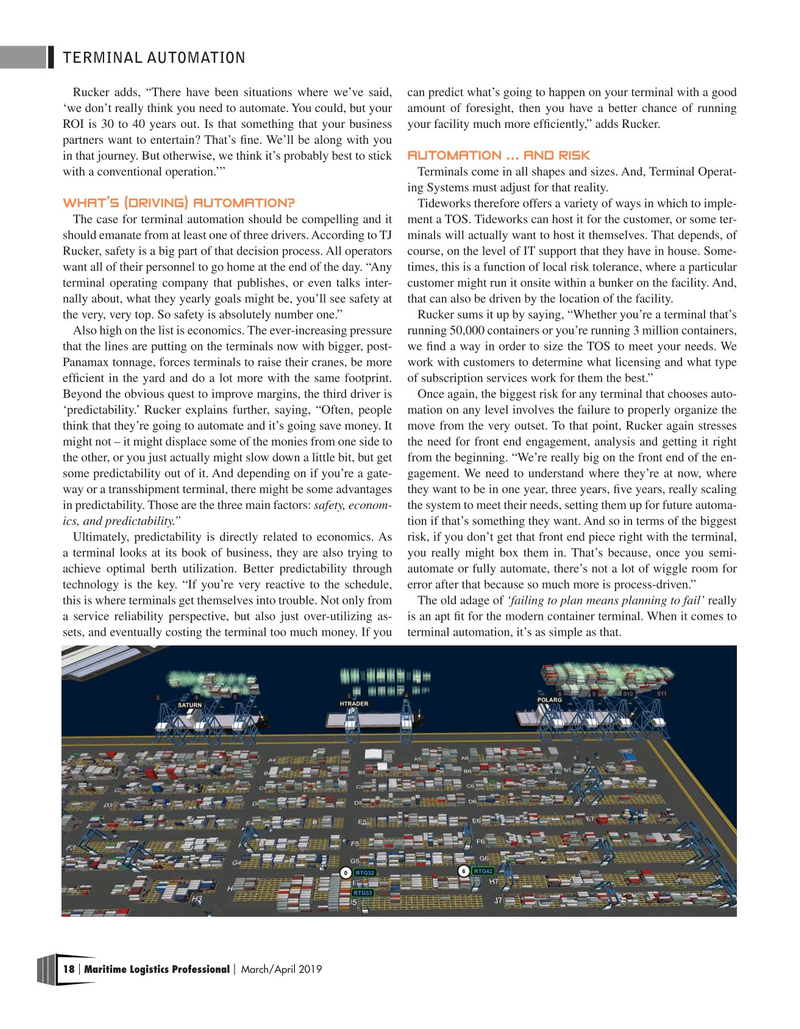
Page 18: of Maritime Logistics Professional Magazine (Mar/Apr 2019)
Container Ports
Read this page in Pdf, Flash or Html5 edition of Mar/Apr 2019 Maritime Logistics Professional Magazine
TERMINAL AUTOMATION
Rucker adds, “There have been situations where we’ve said, can predict what’s going to happen on your terminal with a good ‘we don’t really think you need to automate. You could, but your amount of foresight, then you have a better chance of running
ROI is 30 to 40 years out. Is that something that your business your facility much more ef?ciently,” adds Rucker.
partners want to entertain? That’s ?ne. We’ll be along with you
AUTOMATION … AND RISK in that journey. But otherwise, we think it’s probably best to stick with a conventional operation.’” Terminals come in all shapes and sizes. And, Terminal Operat- ing Systems must adjust for that reality.
WHAT’S (DRIVING) AUTOMATION? Tideworks therefore offers a variety of ways in which to imple-
The case for terminal automation should be compelling and it ment a TOS. Tideworks can host it for the customer, or some ter- should emanate from at least one of three drivers. According to TJ minals will actually want to host it themselves. That depends, of
Rucker, safety is a big part of that decision process. All operators course, on the level of IT support that they have in house. Some- want all of their personnel to go home at the end of the day. “Any times, this is a function of local risk tolerance, where a particular terminal operating company that publishes, or even talks inter- customer might run it onsite within a bunker on the facility. And, nally about, what they yearly goals might be, you’ll see safety at that can also be driven by the location of the facility.
the very, very top. So safety is absolutely number one.” Rucker sums it up by saying, “Whether you’re a terminal that’s
Also high on the list is economics. The ever-increasing pressure running 50,000 containers or you’re running 3 million containers, that the lines are putting on the terminals now with bigger, post- we ?nd a way in order to size the TOS to meet your needs. We
Panamax tonnage, forces terminals to raise their cranes, be more work with customers to determine what licensing and what type ef?cient in the yard and do a lot more with the same footprint. of subscription services work for them the best.”
Beyond the obvious quest to improve margins, the third driver is Once again, the biggest risk for any terminal that chooses auto- ‘predictability.’ Rucker explains further, saying, “Often, people mation on any level involves the failure to properly organize the think that they’re going to automate and it’s going save money. It move from the very outset. To that point, Rucker again stresses might not – it might displace some of the monies from one side to the need for front end engagement, analysis and getting it right the other, or you just actually might slow down a little bit, but get from the beginning. “We’re really big on the front end of the en- some predictability out of it. And depending on if you’re a gate- gagement. We need to understand where they’re at now, where way or a transshipment terminal, there might be some advantages they want to be in one year, three years, ?ve years, really scaling in predictability. Those are the three main factors: safety, econom- the system to meet their needs, setting them up for future automa- ics, and predictability.” tion if that’s something they want. And so in terms of the biggest
Ultimately, predictability is directly related to economics. As risk, if you don’t get that front end piece right with the terminal, a terminal looks at its book of business, they are also trying to you really might box them in. That’s because, once you semi- achieve optimal berth utilization. Better predictability through automate or fully automate, there’s not a lot of wiggle room for technology is the key. “If you’re very reactive to the schedule, error after that because so much more is process-driven.” this is where terminals get themselves into trouble. Not only from The old adage of ‘failing to plan means planning to fail’ really a service reliability perspective, but also just over-utilizing as- is an apt ?t for the modern container terminal. When it comes to sets, and eventually costing the terminal too much money. If you terminal automation, it’s as simple as that.
18 Maritime Logistics Professional March/April 2019 | |

 17
17

 19
19
